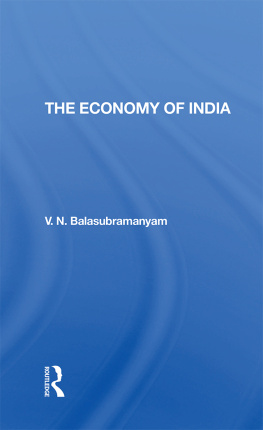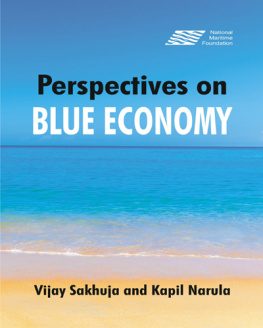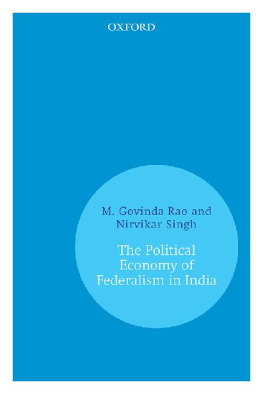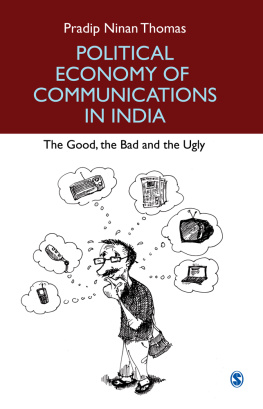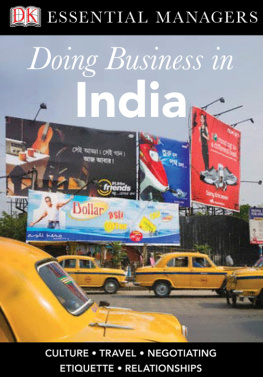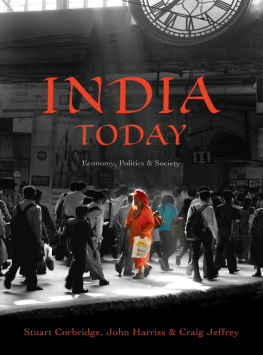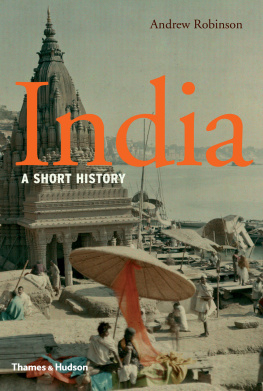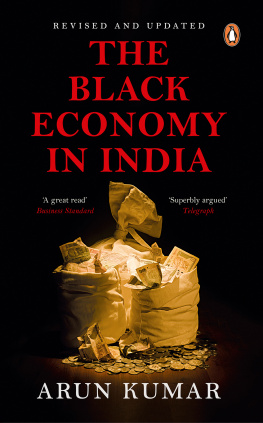THE ECONOMY OF INDIA
The International Economies Series
Already published:
The Japanese Economy by G. C. Allen
The Economies of West Africa by Douglas Rimmer
The Economy of India
V. N. Balasubramanyam
Senior Lecturer in Economics, University of Lancaster
To Maya and Rajeev
First published 1984 by Westview Press
Published 2019 by Routledge
52 Vanderbilt Avenue, New York, NY 10017
2 Park Square, Milton Park, Abingdon, Oxon OX14 4RN
Routledge is an imprint of the Taylor & Francis Group, an informa business
1984 V. N. Balasubramanyam
All rights reserved. No part of this book may be reprinted or reproduced or utilised in any form or by any electronic, mechanical, or other means, now known or hereafter invented, including photocopying and recording, or in any information storage or retrieval system, without permission in writing from the publishers.
Notice:
Product or corporate names may be trademarks or registered trademarks, and are used only for identification and explanation without intent to infringe.
LC 8551220
Typeset by Deltatype, Ellesmere Port
ISBN 13: 978-0-367-29162-4 (hbk)
Five-Year Plans
Formation of the Planning Commission, March 1950
First Five-Year Plan (1951-6)
Second Five-Year Plan (1956-61)
Third Five-Year Plan (1961-6)
Interim Annual Plans (1966-9)
Fourth Five-Year Plan (196974)
Fifth Five-Year Plan (1974-9)
Sixth Five-Year Plan (1980-5)
Wars and Military Conflicts
Indo-Chinese conflict, 20 October 1962 - 21 November 1962
Indo-Pakistan conflict, 5 August 1965 - 23 September 1965
Indo-Pakistan War, 3 December 1971 - 17 December 1975
Indian economic performance has attracted considerable commentary and controversy. Once, during the 1950s and early 1960s, the envy and role model for many developing countries, Indian developmental policies and methods have increasingly drawn critical attention as a number of other economies have registered dramatic gains in growth and in equity with different methods. An overall assessment is clearly necessary.
Dr Balasubramanyam has written a lucid and penetrating review of India's economic performance, which conveys a balanced picture while giving the reader an insight into the lively controversies that India's articulate and talented economists have continually engaged in.
Here the reader will find, for example, a detailed review of critical policy questions such as the pervasive nature of import and industrial controls and their effect on efficiency, growth and poverty, and the grand debate between the proponents of greater outward-orientation of the economy, and its opponents. In the end, Dr Balasubramanyam opts for a more open economy, with greatly reduced reliance on command instruments: but he does it fairly and judiciously, having given due consideration to the critics.
Dr Balasubramanyam's work deserves to be widely read. It will certainly be an invaluable asset to students of development economics who wish to study the Indian experience in depth. It will offer them illumination with pleasure.
Jagdish Bhagwati
New York
Books on India's economic performance and policy are not a rarity. The broad theme of much of the recent literature is India's relatively low-growth performance and the failure of her economic policy to relieve mass poverty and unemployment to any appreciable degree. A number of explanations and prescriptions for India's economic problem have been suggested. These range from critiques of the broad design of India's inward-looking development strategy to analyses of specific aspects of the economy such as the structure and performance of the agricultural sector, the size and course of public-sector investment, productive efficiency of public enterprises, and the impact of private foreign investment and foreign aid on the structure and performance of the economy. There has been an outpouring of books, monographs and articles on these and other aspects of the economy. There are, for instance, four full-length books on India's export performance and policies alone. Such is the immense volume and variety of the literature, that students of economic development attempting to gain a perspective on the Indian economy are likely to find the task forbidding.
This book is intended to help students who are trying to sift this vast literature with a view to gaining an understanding of India's economic problems and obtaining a perspective on the major policy debates. It is, therefore, in the nature of an introductory essay designed to provide a succinct non-technical exposition of India's economic performance and policies. In each of the chapters, an attempt has been made to ground the discussion in the relevant economic theory. The short annotated bibliography at the end of the book provides a guide to further reading.
In the course of writing this book I have incurred an immense intellectual debt to several people. My greatest debt is to my former teacher, Professor Jagdish Bhagwati. His incisive comments on an earlier draft have saved me from a number of conceptual and factual errors and improved the presentation of the book. I owe much to Professor Alasdair MacBean and Dr Peter McCawley for their detailed comments on an earlier draft; and to Dr D. P. Chaudhuri, Dr R. M. Sundrum and Professors Max Corden and Peter Bauer for their comments on parts of the book. I am also indebted to colleagues D. T. Nguyen and O. M. Westall for discussions on the chapters on agriculture and population. I should also thank the publisher's reader for his perceptive comments which have added to both the substance and the presentation of the book. I would also like to acknowledge my gratitude to Dr Robert Baldock, Academic Director of Weidenfeld and Nicolson, for his encouragement and patience in awaiting the completion of the book. I should add that none of these people are in any way responsible for either the errors or the views expressed in the book.
I am grateful to Miss Jane Peill for patiently typing the several drafts of the book.
V. N. Balasubramanyam
Lancaster
1
Introduction
India evokes many images. The familiar one is that of a big, poor democratic country. One in seven of the world's population lives in India, and with a total population of 690 million she ranks second only to China in absolute numbers. She is the seventh biggest country in the world with a total land area of 3.2 million square kilometres. The regions that compose India are extremely heterogenous in their resource endowments, climate, languages and infrastructure. India possesses a wide and varied resource base, including large reserves of iron ore and coal. Although domestic sources supply only a third of India's oil requirements at present, she is reported to possess considerable reserves of crude oil and natural gas. And she is endowed with an efficient Civil Service framework, an inheritance from the days of the British Raj, preserved and nurtured over the past three decades.
Another familiar image of India, somewhat tarnished by the emergency regime in the mid-seventies, is that of the world's most populous democracy; a constitutional democracy which incorporates both the Westminster-style parliamentary government and the US-style federalist structure. While the central parliament is supreme in the spheres of defence, foreign policy and general economic policy, there is also a devolution of certain powers to the states. These include the rights to levy taxes on land and agricultural income. The states are also entitled to grants-in-aid and developmental assistance from the central government, which has the sole right to levy taxes on income and foreign trade.


